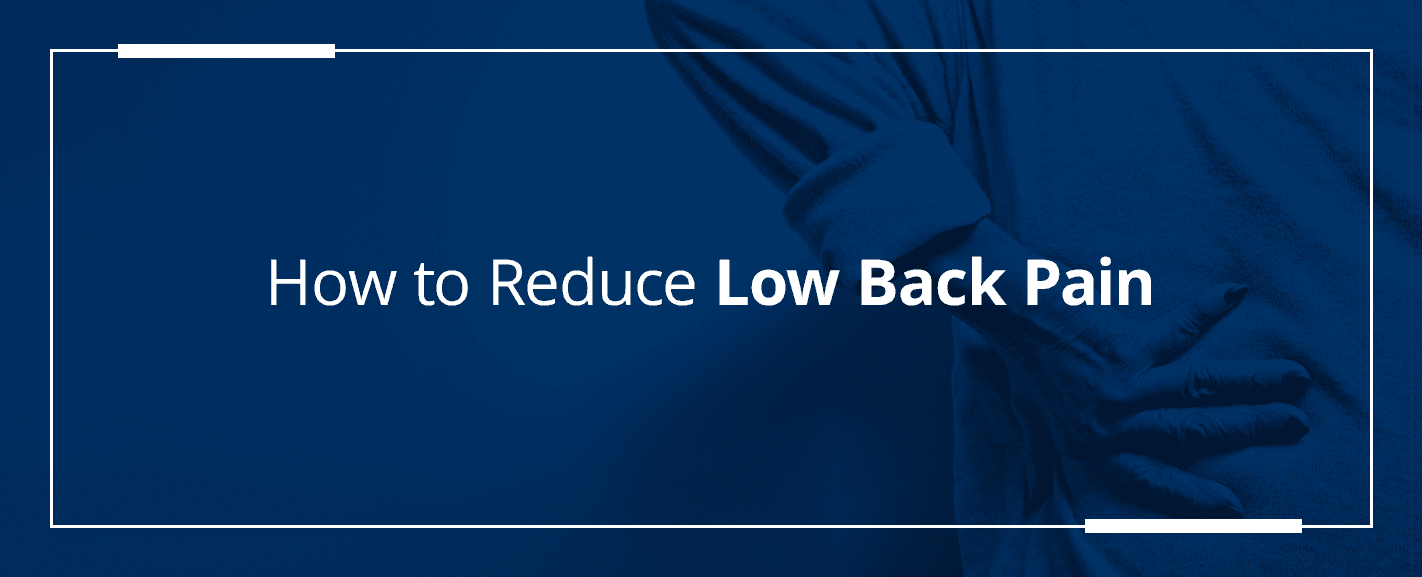
Did you know that low back pain is the leading cause of years lived with disability (YLDs) in the world? Millions of people live with low back pain, negatively impacting their mobility — and ultimately, their quality of life. Understanding what causes low back pain can help you determine what may worsen your symptoms so you can find a solution.
There are numerous effective ways to ease low back pain and manage the associated symptoms. Numerous exercises can strengthen the back muscles to relieve stress, tension and painful symptoms. Other remedies, like rest and heat and ice therapy, can also help. Keep reading to learn more about how to reduce low back pain.
What Causes Lower Back Pain?
Knowing what can cause low back pain is the first step to creating an effective treatment regimen. In most cases, soft-tissue injuries and mechanical issues are the leading cause of low back pain. These injuries may include damaged intervertebral disks, improper movement of the spinal joints and compressed nerve roots.
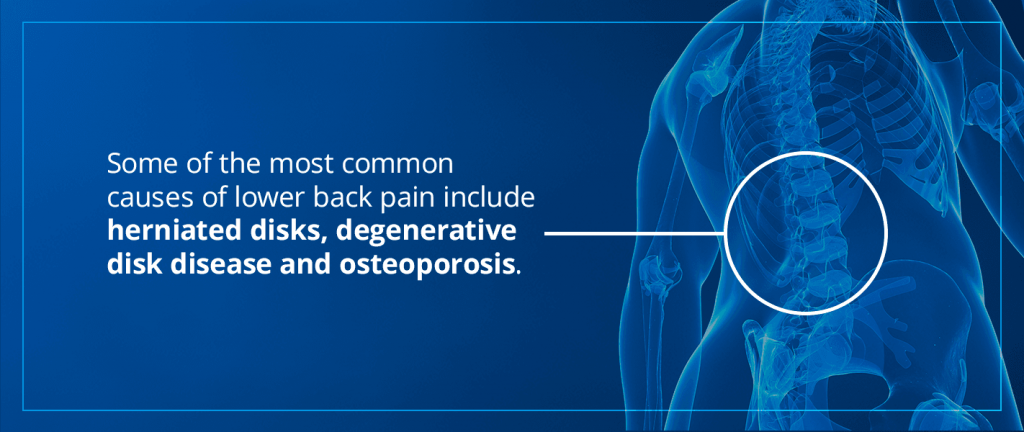
What is low back pain? Essentially, any pain, soreness or discomfort in your lower back could be considered low back pain. Some of the most common causes of lower back pain include:
- Herniated disk
- Degenerative disk disease
- Osteoporosis
- Sciatica
- Facet joint dysfunction
- Scoliosis
- Muscle strain
- Spinal stenosis
- Compression fracture
How to Reduce Low Back Pain
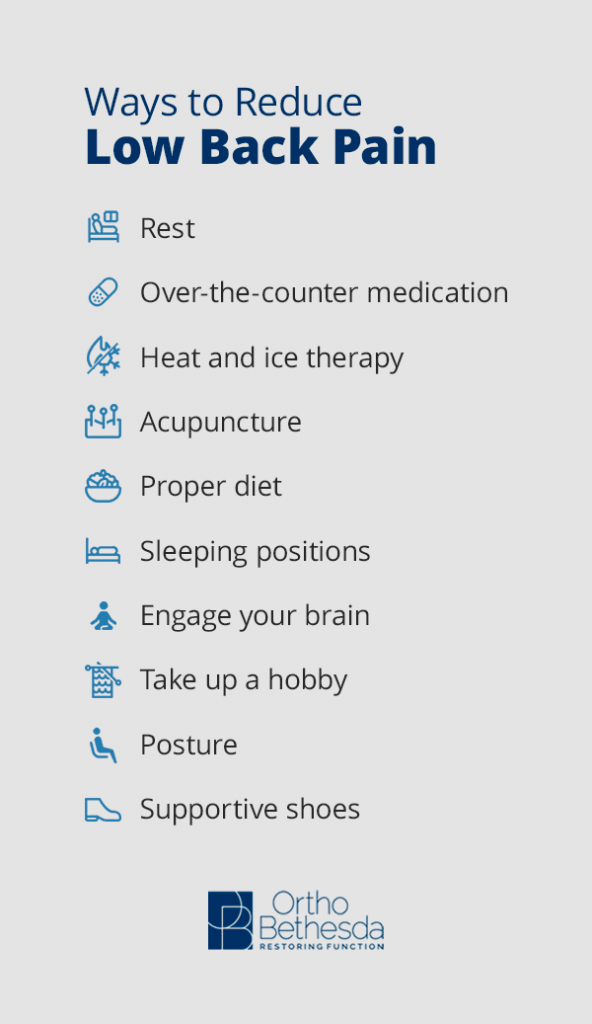
Chronic back pain is a common concern, with approximately 8% of all adults experiencing persistent back pain that results in limited actions and activities. Fortunately, you can explore several ways to treat and relieve low back pain and improve discomfort. Learning how to ease low back pain can help you improve symptoms of low back pain when coughing, standing, walking or resting.
1. Rest
One way to get rid of low back pain or manage the severity of painful symptoms is to ensure you get enough quality sleep. If you experience low back pain when sleeping or lying down, it may be a sign that your mattress isn’t supportive and can’t provide you with the comfort your body needs to sleep. Unfortunately, a lack of sleep can increase a person’s sensitivity to pain, potentially worsening their perception of low back pain.
2. Over-the-Counter Medication
For those who experience low back pain when sitting or standing, over-the-counter pain medications can help relieve pain and discomfort. Additionally, anti-inflammatory medicine can help reduce swelling or inflammation that may add pressure or stress to the lower back and worsen symptoms.
When taking any medication, it’s essential to follow all directions. Furthermore, you should check with your physician about what medication may be right for you. Some medicines can negatively interact with one another, leading to potential complications.
3. Heat and Ice Therapy
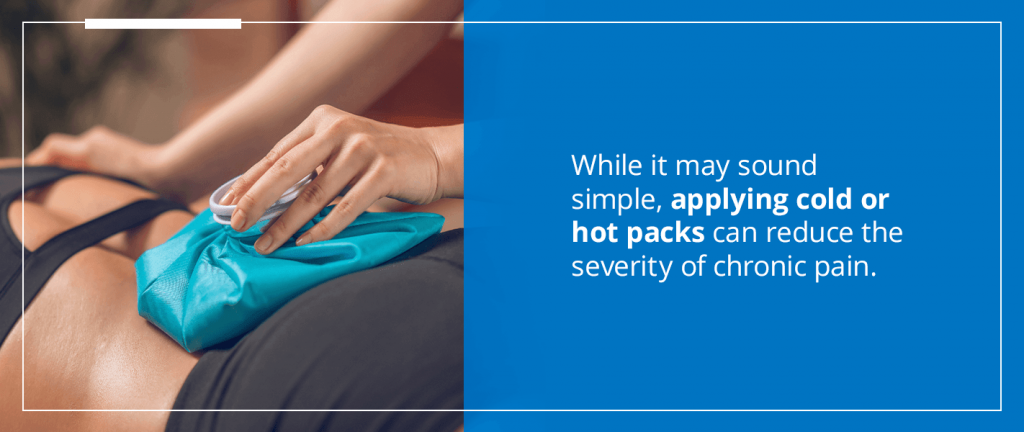
If you experience low back pain when standing, you may want to consider hot and cold treatments to reduce the severity of chronic pain. While it may sound simple, applying cold or hot packs can greatly improve painful symptoms.
Using a cold treatment like an ice pack can help reduce painful inflammation and swelling that can worsen discomfort. On the other hand, heat therapy can provide pain relief, improve blood circulation and induce a more relaxing feeling. Try taking a warm shower or bath, soaking for 15 minutes. A few hours later, apply a covered ice pack to the affected area for the same amount of time.
4. Acupuncture
Acupuncture is a treatment that involves the placement of very thin needles in the skin at strategic points of the body to alleviate pain. Research has shown that it’s more clinically effective for relieving pain and improving function than no treatment at all. Acupuncture can stimulate the body to release important pain-relieving chemicals.
5. Proper Diet
Eating a proper diet is essential to leading a healthy lifestyle, and it can help alleviate lower back pain. That’s mainly because a healthy diet can help you maintain an ideal weight, which can relieve excess strain on the lower back.
Additionally, proper nutrition can also promote healthy bones and bone growth. Some of the most essential nutrients you want to include in your diet are vitamin D, calcium and phosphorous. These nutrients and vitamins can help promote bone growth and lower the severity of painful symptoms.
If you’re experiencing lower back pain, you may want to consider a healthy diet as a way to possibly relieve some of the stress on your back.
6. Sleeping Positions
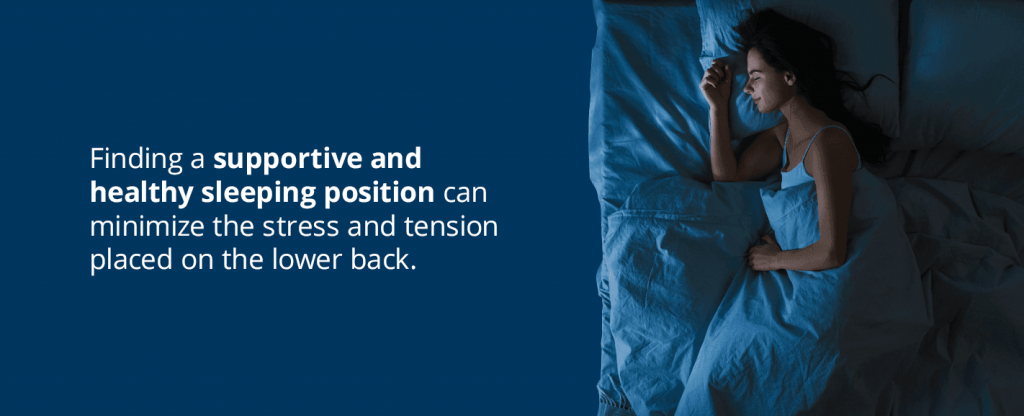
Understanding how to sleep with low back pain is an essential aspect of getting a good night’s rest and restorative sleep. Therefore, your sleep posture plays an important role in the overall quality of your sleep. Finding a supportive and healthy sleeping position can minimize the stress and tension placed on the lower back, reducing painful symptoms.
7. Engage Your Brain
Learning how your brain processes and interprets pain signals is an important aspect in perceiving pain. Fortunately, mindful pain management and other ways of thought have been shown to help reduce the intensity of some pain signals. Many patients have found success by learning and practicing mindfulness meditation, which involves controlling your breath and focusing on the mind. Additionally, cognitive behavioral therapy can help you alter the way you perceive pain.
8. Take Up a Hobby
Many patients may wonder what to do for low back pain, as persistent pain can negatively impact your overall quality of life. If you experience back pain, finding a hobby or way to positively engage your brain can effectively improve your mood and help you focus on a positive activity rather than painful or uncomfortable sensations.
Take up an appropriate hobby for your back that minimizes the risk of injury or stress on the spine. Even something as simple as enjoying time with a friend once a week can help stimulate the release of feel-good endorphins. Because endorphins stimulate the opiate receptors in our brain, they can reduce pain while boosting pleasure and positive emotions.
9. Posture
Maintaining a healthy posture when performing physical activities or sitting can help prevent lower back pain from occurring or worsening. If you notice low back pain when bending over, adjust your posture accordingly to protect your lower back from stress or injury. If you play sports, have a physically demanding job or perform repetitive motions, your posture is an essential element to consider.
To promote back health, avoid slouching or hunching. If you’re lifting a heavy object, you should bend and straighten from the knees to lift instead of using your back. When twisting, you should ensure you rotate your hips from side to side. If you have a desk job or spend much of your day sitting, you should use a chair or pillow that offers lower back support.
10. Supportive Shoes
Wearing shoes that don’t offer proper support can cause muscular strains on the legs, neck and back. Additionally, high heels can cause the body’s alignment to be negatively impacted, leading to a higher potential for lower back pain. Very flat shoes can also place added strain on the back or feet.
If you experience low back pain when bending forward or walking, you may want to consider supportive shoes and footwear. In some cases, visiting a foot specialist can be helpful, as they can suggest proper footwear and inserts.
The Importance of Exercise for Your Lower Back Pain
A proper exercise routine is essential to leading an active and healthy lifestyle. Additionally, exercises can help strengthen lower back muscles to alleviate existing lower back pain and prevent back pain from developing. Certain activities can also stabilize and strengthen the core, arms and legs. Routine exercise can even help improve blood flow and circulation in the lower back, promoting the body’s natural healing process and reducing overall stiffness.
When it comes to back pain, aerobic exercise can increase the nutrients and blood flow to the back’s soft tissue to improve the healing process and reduce painful symptoms. Strengthening the muscles that support the spine is key to helping alleviate excess pressure or stress on the facet joints and spinal disks. Stretching is also a helpful way to loosen tension in the back.
When you exercise, your body releases endorphins, which can help promote a positive mood and naturally relieve pain and discomfort. Frequently releasing endorphins can help minimize the need for pain medication and improve symptoms overall. Because stress, anxiety and depression are common side effects of chronic pain, a healthy release of endorphins plays an important role.
10 Exercises to Reduce Lower Back Pain
There are various exercises and stretches that can treat low back pain and improve spinal stress and discomfort. Before starting a new exercise routine, you should always consult with your physician. Some exercises or stretches may stress the spine and attractive chronic pain or existing discomfort. Creating an effective, physician-approved exercise routine can help reduce chronic pain.
A few of the most effective exercises to relieve lower back pain include:
1. Knee-to-Chest Stretch
The knee-to-chest stretch is an effective activity that can help elongate the lower back to relieve pain and tension.
- To begin the knee-to-chest stretch, lie on your back with your feet flat on the ground and knees bent.
- With both hands, gently grab your lower right leg and clasp your fingers under the knee.
- Keep your left foot flat on the ground and gently bring your right knee up towards your chest until you notice a stretch in the lower back.
- Hold the stretch for 30 to 60 seconds or as long as it’s comfortable for you.
- After lowering your leg, you can repeat the stretch with your left leg.
For each leg, you can perform the stretch three times.
2. Trunk Rotations
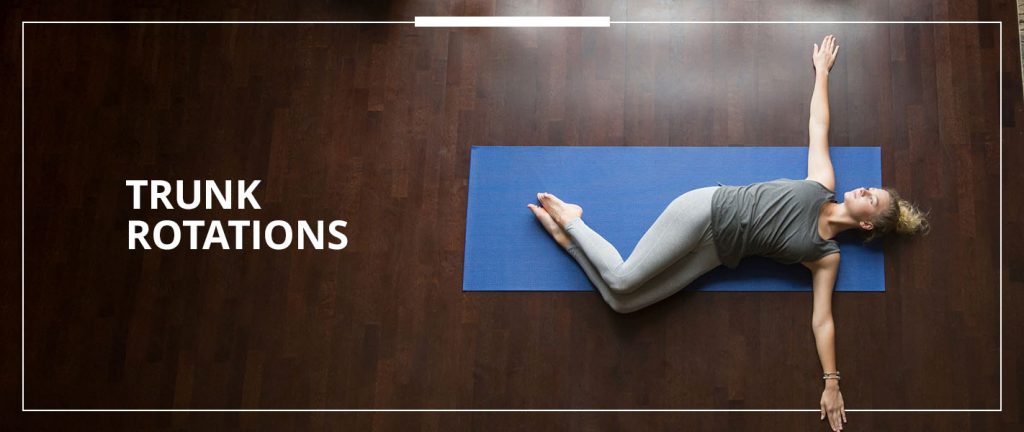
A trunk rotation can help relieve built-up tension in the lower back. This stretch works by stimulating various muscles, including the back, pelvic and abdominal muscles.
- To start the trunk rotation stretch, lie on the floor on your back and bring your knees towards your chest, similar to sitting in a chair.
- Extend your arms to the sides with the palms of your hands facing down to the floor.
- Keep your knees together with your hands on the floor and gently roll both knees to the right side of your body, holding for 10 to 20 seconds.
- Return your legs to the initial starting position and repeat the process on the left side of your body.
Repeat these stretches three to five times on each side.
3. Pelvic Tilt
A pelvic tilt can help release tight or tense back muscles and maintain the flexibility of these muscles.
- To perform a pelvic tilt, lie down on your back with your knees bent, arms by your sides and feet flat on the floor. The spine’s natural curvature will help to raise the lower back off the floor slightly.
- Gently push your stomach out to stabilize your core.
- Hold this pose for approximately 10 seconds, and then relax your body.
- Push your pelvis up slightly towards the ceiling while making sure your pelvis doesn’t leave the floor.
- Tighten your abdominal muscles and buttocks, noting the sensation of your lower back pressing into the floor.
- Hold this position for approximately 10 seconds and then relax.
Repeat this activity 10 to 15 times.
4. Hamstring Stretches
While many people may overlook this muscle group, tight hamstrings can contribute to persistent lower back pain. If you feel tightness in the back of your thighs, your hamstrings may be too tight, and stress will be placed on the sacroiliac joints and lower back, potentially leading to more pain. When performing hamstring stretches, you must be careful and not overextend the muscle.
There are numerous types of hamstring stretches, including supine hamstring stretches, standing hamstring stretches and more. Finding the hamstring stretch that works best for your activity level and is most effective at relieving lower back pain or discomfort is important. While hamstring stretches are effective, you’ll want to choose the variation that places the least amount of stress on your lower back.
5. Yoga
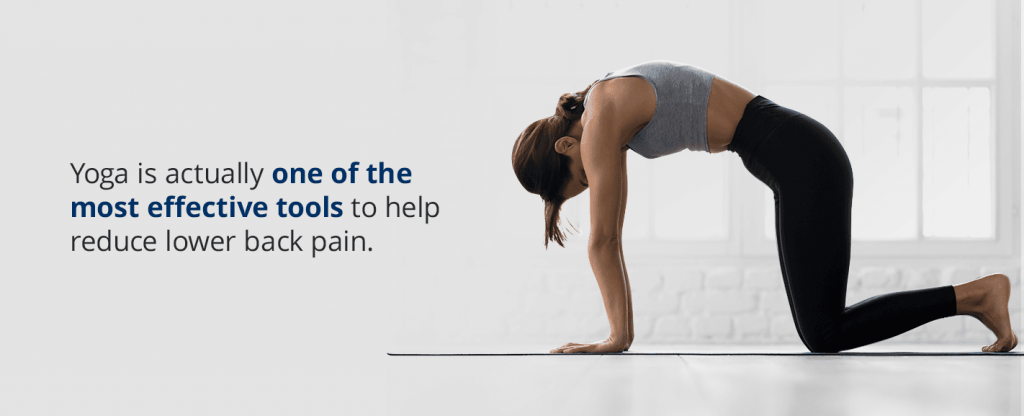
Yoga is a body and mind practice that combines meditation, breathing techniques, relaxation and physical postures. It’s actually one of the most effective tools to help reduce lower back pain. Another benefit is that it helps promote stress relief for any tension you may hold in your lower back.
Many patients can start with simple exercises, including mindfulness meditation or the child’s pose, which is helpful for tension in the lower back. Some of the most popular poses for back pain relief include the cat-cow stretch, downward-facing dog, bridge pose and more. Many poses also feature modifications you can use if you’re still working on your flexibility.
6. Partial Crunches
This version of crunches is an exercise that can help stabilize and strengthen the core while building strength in the lower back and related abdominal muscles.
- To perform a partial crunch, lie on your back and keep your feet flat on the floor while bending your knees. Either cross your arms across your chest or gently place your hands behind your head.
- Keep your stomach engaged and your abdominal muscles tight. Breathe out while raising your shoulders and avoid leading with your elbows, which can strain the neck.
- Hold this position for one second and gently lower yourself back to the floor.
Repeat this move 10 to 12 times. Following proper form during this exercise is essential to prevent stress on the spine.
7. Wall Sits
Here’s a simple, engaging exercise that can help alleviate tension on the spine and improve lower back pain.
- To begin, stand with your back close to the wall.
- Carefully lean into the wall until your back is flat against it.
- Slowly slide down the wall until your knees are slightly bent and continue to press your low back into the wall.
- Hold this wall sit position until the count of 10 and slightly raise up out of the position.
Repeat this movement 10 to 12 times.
8. Press-Up Back Extensions
This is an effective exercise that can help ease pain and discomfort in the lower back.
- To perform a press-up back extension, lie on your stomach and position your hands beneath your shoulders.
- Gently push down on your hands, and you should feel your shoulders begin to lift away from the floor. If possible, set your elbows on the floor underneath your shoulders.
- Hold this position for 10 seconds or however long is comfortable for you.
Repeat this pose six to eight times.
9. Supported Bridges
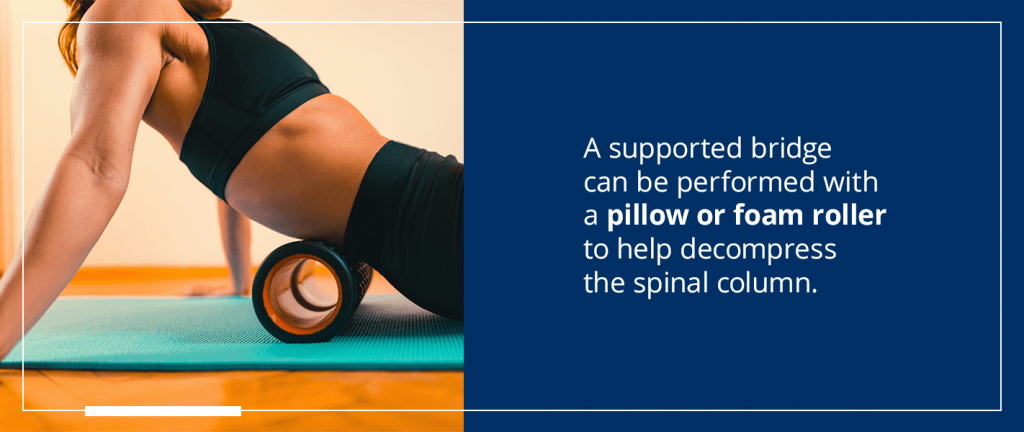
A supported bridge can be performed with a pillow or foam roller to help decompress the spinal column and lower back through supported elevation.
- To start, lie down on your back with your feet flat on the floor and your knees bent.
- As you raise your hips, place the pillow or foam roller under your hips. Let your body relax into the support.
- Hold this position for 30 to 60 seconds and feel the decompression of your lower back.
Repeat this exercise three to five times with a one-minute rest between sets.
10. Flexion Rotation
The flexion rotation exercise can help to stretch the buttocks and lower back.
- To start, lie on the right side of your body with straight legs.
- Bend your left leg and bring your foot behind your right knee.
- Gently grasp your left knee with your right hand and put your left hand under your neck.
- Twist your upper body back until touch your left shoulder to the floor.
- Hold the position for one to three seconds before slowly moving out of the rotation.
Repeat the stretch 10 times on either side of your body.
When to See a Doctor for Your Lower Back Pain
Knowing when to see a doctor for lower back pain is an important step to find relief. First, you’ll want to consider if your lower back pain is acute or chronic. While acute lower back pain is a short-term condition that typically improves within a few weeks or months, chronic back pain is long-term and may be persistent even if you experience some periods of relief.
There are several red flags to look out for when determining if you should see a doctor for lower back pain. These warning signs may indicate an underlying issue, such as a spinal infection, tumor or fracture. Even if you don’t experience these symptoms, seeing a physician may still help you create an effective treatment to manage back pain.
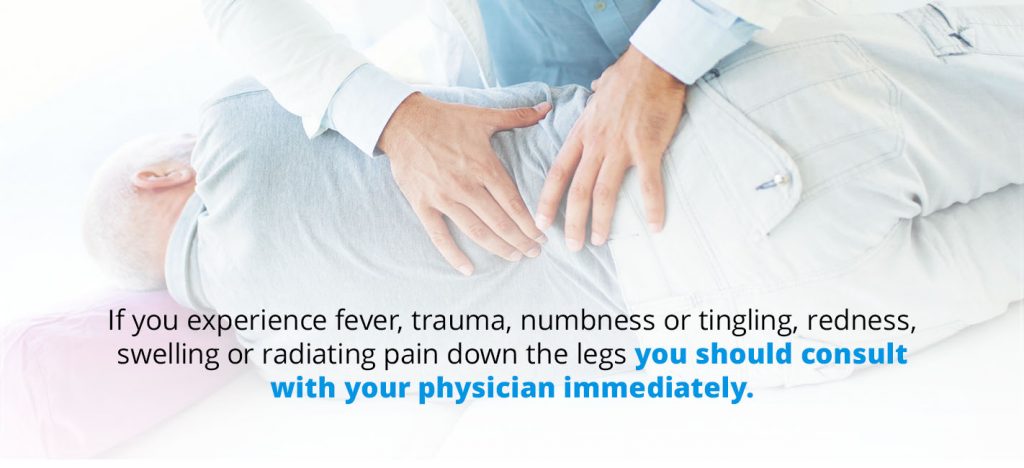
If you experience low back pain with any of the following symptoms, you should schedule an appointment with your physician immediately:
- Fever
- Trauma
- Numbness or tingling
- Dragging feet
- Significant weight loss
- Weakness
- Redness and swelling
- Radiating pain down the legs
- Loss of bladder or bowel control
- Medical history of cancer, osteoporosis, chronic steroid use or suppressed immune system
Innovative Orthopedic Care and Treatment at OrthoBethesda
We at OrthoBethesda are dedicated to providing the highest level of patient care possible. Our board-certified orthopedic surgeons are experts in treating various conditions related to the spine, bones and joints. We offer innovative treatments for orthopedic conditions related to the hands, knees, hips, elbows and more. This includes conditions such as ligament and tendon injuries, fractures and sports-related concerns.
To learn more about orthopedic treatments and physical therapy, contact OrthoBethesda online today or call (301) 530-1010.
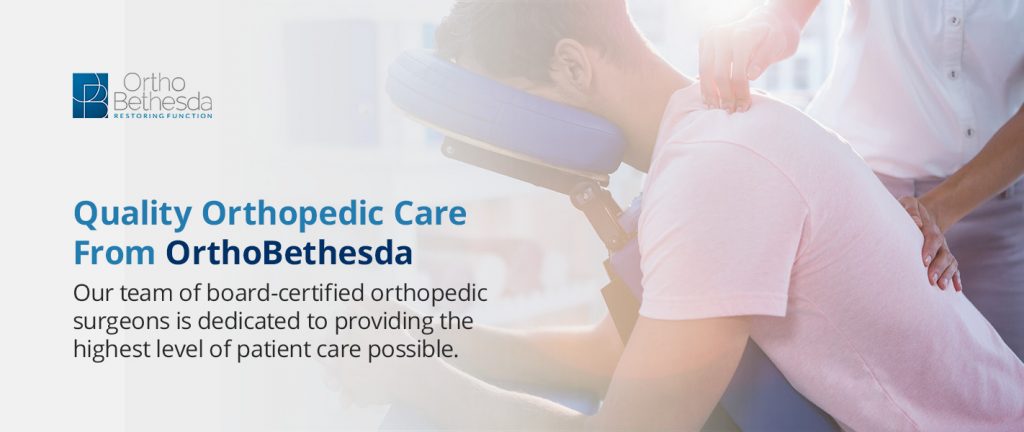
Related Content
- How to Prevent Back Pain When Working From Home
- How to Sleep After Back Surgery
- 10 Steps to Achieving Better Posture
- How to Sleep With a Herniated Disc
- How to Know if You Have a Herniated Disc
- Spinal Fusion Surgery – Commonly Asked Questions
- Spine Surgery: When It Works and When It Doesn’t
- Dr. Eric Feuchtbaum Makes Advancements in Minimally Invasive Spine Surgery With Mazor Robotics
- What Is Kyphosis?
- What Causes Sciatica Nerve Pain?
- Everything to Know About Scoliosis

